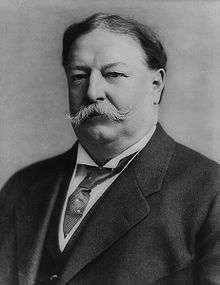United States Supreme Court Building
The Supreme Court Building houses the Supreme Court of the United States. Completed in 1935, it is in Washington, D.C. at 1 First Street, NE, in the block immediately east of the United States Capitol. The building is managed by the Architect of the Capitol. On May 4, 1987, the Supreme Court Building was designated a National Historic Landmark.[1][2]
Supreme Court Building | |
 West Façade | |
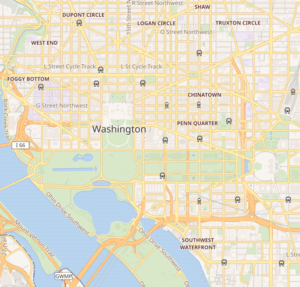  | |
| Location | 1 First Street, Northeast Washington, D.C. |
|---|---|
| Coordinates | 38°53′25.8″N 77°0′16.2″W |
| Built | 1932–1935 |
| Architect | Cass Gilbert, Cass Gilbert Jr. |
| NRHP reference No. | 87001294[1] |
| Designated NHL | May 4, 1987[1] |
| This article is part of the series on the |
| United States Supreme Court |
|---|
 |
| The Court |
| Current membership |
| Lists of justices |
|
| Court functionaries |
|
The building is the official residence and workplace of the Supreme Court Justices of the United States. This building was also referred to as The Marble Palace by John P. Frank,[3] and is located at One First Street within a mile of the Library of Congress, NE Washington.[4] The physical construction of this building began in 1932 and was completed in 1935, however, the idea to create this building originated from President William Howard Taft in 1912,[4] the process started under Taft when he served as Chief Justice and was officially completed under the guidance of Chief Justice Hughes.[4] The building was designed by Cass Gilbert, who was a well-known architect and friend to Chief Justice Taft.[5]
History
Prior to the establishment of the Federal City, the United States government resided briefly in New York City. The Supreme Court met there in the Merchants Exchange Building. When the capital moved to Philadelphia, Pennsylvania, the Court moved with it and began meeting in Independence Hall, before settling in Old City Hall at 5th and Chestnut Streets from 1791 until 1800.[6]
After the federal government moved to Washington, D.C., the court had no permanent meeting location until 1810. When the architect Benjamin Henry Latrobe had the second U.S. Senate chamber built directly on top of the first US Senate chamber, the Supreme Court took up residence in what is now referred to as the Old Supreme Court Chamber from 1810 through 1860.[7] It remained in the Capitol until 1935, with the exception of a period from 1812 to 1819, during which the Court was absent from Washington because of the British invasion and the destruction of the Capitol during the War of 1812.[6]
In 1810 the Supreme Court first occupied the Old Supreme Court Chamber in the Capitol.[6] As the Senate expanded, it progressively outgrew its quarters. In 1860, after the new wings of the Capitol for the Senate and the House of Representatives had been completed, the Supreme Court moved to the Old Senate Chamber (as it is now known) where it remained until its move to the current Supreme Court building.
The physical construction of this building began in 1932 and was completed in 1935, however the idea to create this building originated from Chief Justice William Howard Taft in 1912[4] and was officially completed under the guidance of Chief Justice Hughes.[4] In 1929, Chief Justice Taft argued successfully for the Court to have its own headquarters to distance itself from Congress as an independent branch of government, but he did not live to see it built. The court was finally designed by Cass Gilbert, who was a well-known architect and friend to Taft, and created many other structures in the United States.[8]
Motivations for the creation of the Supreme Court Building
From 1860 to 1935, the Supreme Court Justices were designated to conduct their work within the cramped space of the old Senate Chamber[9] alongside other federal government employees. This environment discouraged the Supreme Court Justices from travelling to Washington, so they conducted most of their work from their homes.[10] Before the Supreme Court building was approved, Charles Evans Hughes, who had been an Associate Justice from 1910 to 1914, was vocally outspoken about the poor conditions of the justices's working environment and described the Old Senate Chamber as small, overheated, and barren.[11] Through the rigorous lobbying efforts of Chief Justice Taft, he was able to secure the funding needed from Congress for a Supreme Court building in 1929.[10] Taft's motivations for a Supreme Court building were fueled by the relationship between the judicial branch and the other branches of government,[12] as well as the drastic differences in his working environment from when he served as President of the United States to when he served as Chief Justice. Taft envisioned the judicial branch of government to embody a persona of independence, and therefore saw the Supreme Court building as a means of establishing his vision.[11]
The Supreme Court building would not have been completed without the further commitment of Charles Evans Hughes, who succeeded Taft as Chief Justice in 1930.
Opposition to the Supreme Court Building

Chief Justice White was part of the initial resistance to the idea of a Supreme Court building. He argued that the Supreme Court obtained its relevance because of its location within the Capitol.[11] Many Justices in addition to Justice White refused to conduct their work within the building, and remained in their homes.[11] The familiarity of their work spaces at home naturally discouraged the justices from operating in a completely new location, and they were also given funding by Congress to work from their homes.[13]
Justices Harlan Stone and Louis Brandeis did not move into the new Supreme Court Building during their service on the court.[14] Brandeis believed that Taft's intentions behind the new building represented a conflict between the judicial branch and the executive and legislative branches of government.[14] Brandeis also opposed Taft's efforts to secure a new Supreme Court building by suggesting that a new wing should be added to the capitol to avoid having to work from his home;[14] however Taft was relentless in pursuing his vision for the Supreme Court. A decade after the Supreme Court building was complete, all nine justices occupied an office within its body.[15] This is primarily because the justices that did not favor the new Supreme Court Building were eventually replaced by new justices who were not as familiar with working from home.[16]
The main opposition to the creation of the Supreme Court building was in Congress, particularly during Taft's tenure as Chief Justice from 1921 to 1929. Taft faced opposition from senators in Congress, such as Senator Curtis, who threatened to replace Taft if he continued to protest his working conditions.[13] In 1927, Taft noticed that out of ninety-six total senators at the time, only one urgently supported Taft's lobbying efforts; but only because this senator wanted the space the justices occupied at that time for the Senate.[17]
Temple of Justice
The Supreme Court Building is located at 1 First Street, NE (former site of the Old Brick Capitol, across the street from the United States Capitol) and was designed by architect Cass Gilbert (as Gilbert's last major project; he died before it was completed). Gilbert was a long-time friend to William Howard Taft, and was employed for several years by McKim, Mead and White, then regarded as the largest architectural firm in the world.[13] Chief Justice Taft personally appointed Gilbert for the architectural planning and construction of the Supreme Court building.[12] Gilbert was not particularly concerned with the function of the Supreme Court building for the Supreme Court Justices; however, the respect Gilbert had for Chief Justice Taft compelled him to design the building as a testament to his friend's honor.[5] Gilbert's architectural imagination resulted in a Greek styled temple which was intended to communicate the inherent royalty of law.[11]

The Supreme Court Building is in the Neoclassical style and rises four stories (92 ft (28 m)) above ground. The cornerstone was laid on October 13, 1932, and construction completed in 1935 for slightly under the $9,740,000 budget authorized by Congress ($142 million in 2018 dollars).[18] "The building was designed on a scale in keeping with the importance and dignity of the Court and the Judiciary as a coequal, independent branch of the United States Government, and as a symbol of 'the national ideal of justice in the highest sphere of activity.'"[6] The public façade is made of marble quarried from Vermont, and that of the non-public-facing courtyards, Georgia marble. Most of the interior spaces are lined with Alabama marble, except for the Courtroom itself, which is lined with Spanish ivory vein marble.[19] For the Courtroom's 24 columns, "Gilbert felt that only the ivory buff and golden marble from the Montarrenti quarries near Siena, Italy" would suffice. To this end, in May 1933, he petitioned the Italian Prime Minister, Benito Mussolini, "to ask his assistance in guaranteeing that the Siena quarries sent nothing inferior to the official sample marble."
Not all the justices were thrilled by the new arrangements, the courtroom in particular. Harlan Fiske Stone complained it was "almost bombastically pretentious...Wholly inappropriate for a quiet group of old boys such as the Supreme Court." Another justice observed that he felt the court would be "nine black beetles in the Temple of Karnak", while still another complained that such pomp and ceremony suggested the justices ought to enter the courtroom riding on elephants. The New Yorker columnist Howard Brubaker noted at the time of its opening that it had "fine big windows to throw the New Deal out of."[20]

The west façade of the building bears the motto "Equal Justice Under Law", while the east façade bears the motto "Justice, the Guardian of Liberty." On November 28, 2005, a basketball-sized chunk of marble weighing approximately 172 lb (78 kg) fell four stories from the west façade onto the steps of the Court; it had previously been part of the parapet above the word "under" in the "Equal Justice Under Law" engraving immediately above the figure of a Roman centurion carrying fasces. After the incident, planning was initiated to repair the west façade, which included cleaning, removal of debris, and restoration. In 2012 scaffolding encased the west façade printed with a full-size photograph of the façade. The project was completed in 2013.[21]
The Supreme Court Building's facilities include:
- Basement: maintenance facilities, garage, on-site mailroom.
- First (or ground) floor: Public information office, the clerk's office, the publications unit, exhibit halls, cafeteria, gift shop and administrative offices.
- Second floor: the Great Hall, the courtroom, the conference room, and all of the justices' chambers except Justice Sotomayor (she swapped with Justice Ginsburg for a roomier office on the third floor).
- Third floor: The office of Justice Sotomayor, the office of the Reporter of Decisions, the legal office, and the offices of the law clerks. Also, the justices' dining and reading rooms are on this floor.
- Fourth floor: The court library
- Fifth floor: The Supreme Court gym, including a basketball court (named the "Highest Court in the Land")[22]
Originally built as a storage area, the gym was converted to its current state in the late 1940s, although who is responsible for the transformation is not known. Some have said that it was at the suggestion of architect Cass Gilbert, Jr. who took over many of his father's projects after he died. Among the justices known for their on-court prowess was Justice Byron White who, as the runner-up for the 1937 Heisman Trophy and former National Football League player, is considered to be the Supreme Court's preeminent sportsman. Among the Supreme Court clerks who have played is Fox News commentator Laura Ingraham, a critic of the National Basketball Association, and current Supreme Court Justices Elena Kagan and Brett Kavanaugh. Near the entrance to the gym is a sign that reads "PLAYING BASKETBALL AND WEIGHT LIFTING ARE PROHIBITED WHILE THE COURT IS IN SESSION".[23]
A. Hall and Sons Terra Cotta of Perth Amboy, New Jersey created the terra cotta roof for the building.
The Supreme Court Building maintains its own police force, the Supreme Court Police. Separate from the Capitol Police, the force was created in 1935 to look after the building and its personnel.
Sculptural program
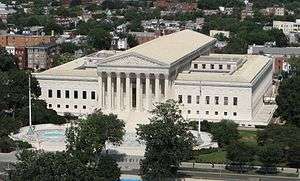
- Cass Gilbert's design for the building and its environs included an ambitious Beaux-Arts-styled sculptural program that included a large number and variety of both real and allegorical figures
- Supreme Court flagpole bases, and bronze doors in the east and west façades by John Donnelly.
- East pediment: Justice, the Guardian of Liberty by Hermon Atkins MacNeil
- West pediment: Equal Justice Under Law by Robert Ingersoll Aitken. This work includes a portrait of Cass Gilbert, third from the left in the pediment. It also contains a self-portrait of Robert Ingersoll Aitken third from the right.
- Statues: The Authority of Law (south side) and The Contemplation of Justice (north side) by James Earle Fraser
- Great Hall: Busts of each of the Chief Justices of the United States in alcoves on either side of the Hall. These marble works are periodically appropriated by the Congress. The most recent addition was Chief Justice William Rehnquist's bust in December 2009 to the far end of the north side of the Hall, just to the left of the Courtroom doors.
- Courtroom friezes: The South Wall Frieze includes figures of lawgivers from the ancient world and includes Menes, Hammurabi, Moses, Solomon, Lycurgus, Solon, Draco, Confucius, and Augustus. The North Wall Frieze shows lawgivers from the Middle Ages on and includes representations of Justinian, Muhammad, Charlemagne, John, King of England, Louis IX of France, Hugo Grotius, Sir William Blackstone, John Marshall, and Napoleon. The Moses frieze depicts him holding the Ten Commandments, although only commandments six through ten, usually considered the more secular commands, are visible. In 1997, the Council on American-Islamic Relations (CAIR) asked for the image of Muhammad to be removed from the marble frieze of the façade. While appreciating that Muhammad was included in the court's pantheon of 18 prominent lawgivers of history, CAIR noted that Islam discourages depictions of Muhammad in any artistic representation. CAIR also objected that Muhammad was shown with a sword, which they claimed reinforced stereotypes of Muslims as intolerant conquerors. Chief Justice William Rehnquist rejected the request to sandblast Muhammad, saying the artwork "was intended only to recognize him, among many other lawgivers, as an important figure in the history of law; it is not intended as a form of idol worship". The court later added a footnote to tourist materials, calling it "a well-intentioned attempt by the sculptor to honor Muhammad".[24]
 United States Supreme Court bronze doors.
United States Supreme Court bronze doors.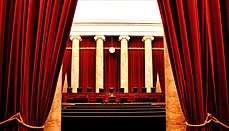 The Supreme Court courtroom interior with its Siena marble.
The Supreme Court courtroom interior with its Siena marble.- View of the Alabama marble in the hallway.
- One of two self-supporting spiral staircases in Alabama marble.
- Equal Justice Under Law over the western façade.
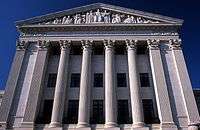 Justice the Guardian of Liberty over the eastern façade.
Justice the Guardian of Liberty over the eastern façade. Flagpole base.
Flagpole base.- The Contemplation of Justice statue.
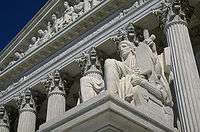 The Authority of Law statue.
The Authority of Law statue.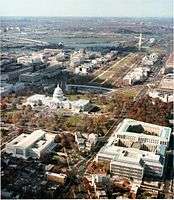 Aerial view of Washington D.C., showing position of the courthouse (lower left) in relation to the Capitol building.
Aerial view of Washington D.C., showing position of the courthouse (lower left) in relation to the Capitol building. The Supreme Court Building of the United States
The Supreme Court Building of the United States
Public access to the building
On May 3, 2010, citing security concerns and as part of the building's modernization project, the Supreme Court announced that the public (including parties to the cases being argued, the attorneys who represent them, and visitors to Oral arguments or the building) would no longer be allowed to enter the building through the main door on top of the steps on the west side.[25] Visitors must now enter through ground-level doors located at the plaza, leading to a reinforced area for security screening. The main doors at the top of the steps may still be used to exit the building.[25] Justice Breyer released a statement, joined by Justice Ginsburg, expressing his opinion that although he recognizes the security concerns that led to the decision, he does not believe on balance that the closure is justified.[26] Calling the decision "dispiriting", he said he was not aware of any Supreme Court in the world that had closed its main entrance to the public.[26]
All visitors to the Court must pass through metal-detectors and have their belongings X-rayed. Cameras are permitted in the building, but no recording devices of any kind, audio, or visual, are ever permitted in the Courtroom. When the Court is not in session, visitors can walk through the Great Hall and public areas on the ground floor, including the cafeteria and a small movie theater presenting a documentary of the Court, and guided lectures are periodically given in the Courtroom, which is not otherwise accessible. The schedule for the lectures can be confirmed on the Court's website the day before a visit. The line for these tours forms in a designated area to the side of the Courtroom doors.[27]
When the Court is in session, the Great Hall is not open to the public, except for those attending Court. The arguments are typically held in two-week cycles of a 10 A.M. and 11 A.M. argument on Mondays, Tuesdays, and Wednesdays.[28] Depending on the significance of the case and the time of year (winter arguments are less popular), visitors should arrive at the Court anywhere from two hours in advance to, in extremely controversial cases, the night before. At some point in the morning, which is not predetermined, the Supreme Court Police Officers distribute numbered tickets. These serve as place-holders only and not a guarantee of admission. Visitors who have tickets may leave the area and return at the appointed time to line up in numerical order, usually one hour before the argument. At this time, there usually are several hundred persons waiting outside the Court, most of whom are not able to observe either argument.[29] While the Courtroom does have seating for some 250 public visitors, in practice there are almost always large groups of students or officials that reduce that number, and visitors who are admitted to observe the first argument generally stay for the second argument, making the total seats available for the second argument generally very small. Just before the first argument, the officers divide the crowd into two lines: one is for those waiting with tickets to observe the entire argument, while the other is to observe a five-minute span of the argument while standing in the back of the Courtroom. Both lines remain in place during the first argument. Visitors must stand when the Justices enter and leave, and remain absolutely silent. Drowsy, noisy, or otherwise disruptive visitors are promptly removed by plainclothes officers.[27]
Since recording devices have been banned inside the courtroom, the fastest way for decisions of landmark cases to reach the press is through the Running of the Interns.[30]
See also
- List of National Historic Landmarks in the District of Columbia
- Lain in repose - As an honor for a deceased Supreme Court Justices, they can "lie in repose" in the Great Hall of the United States Supreme Court Building
References
- "Supreme Court Building". National Historic Landmarks Program. National Park Service. Archived from the original on December 26, 2011. Retrieved June 18, 2009.
- "Photos, exterior and interior, of the U.S. Supreme Court Building". National Park Service. Note that photos but not National Historic Landmark nomination text, if any exists, are available on-line.
- Nelson, Garrison (2013). Pathways to the US Supreme Court: From the Arena to the Monastery.
- Commission on the Bicentennial of the United States Constitution; Frank and Virginia Williams Collection of Lincolniana (Mississippi State University Libraries) (1992). The Supreme Court of the United States: Its Beginnings & Its Justices, 1790–1991. Washington, D.C.: Commission on the Bicentennial of the United States Constitution. pp. 248–249. OCLC 25546099.
- Roussin, Lucille A. (Winter 2017). "Symposium: The Cultural Identity and Legal Protection of Art: The Temple of American Justice: The United States Supreme Court Building". Chapman Law Review. Vol. 20. p. 51.
- "Overview of the Supreme Court Building". United States Supreme Court. Retrieved March 19, 2010.
- Rehnquist, William H. (2001). The Supreme Court (2nd ed.). Vintage Books. p. 24. ISBN 0-375-70861-8.
- "Study for Woolworth Building, New York". World Digital Library. December 10, 1910. Retrieved July 25, 2013.
- Rehnquist, William H. (2001). The Supreme Court. New York: Knopf.
- Baum, Lawrence (2019). The Supreme Court.
- Schwartz, Bernard (1993). A History of the Supreme Court. New York: Oxford University Press.
- Post, Robert (May 2001). "Article: The Supreme Court Opinion as Institutional Practice: Dissent, Legal Scholarship, and Decisionmaking in the Taft Court". Minnesota Law Review. Vol. 85. p. 1267.
- Maroon, Fred J. & Maroon, Suzy (1996). The Supreme Court of the United States. New York: Thomasson-Grant & Lickle.
- Douglas, William O. (1980). The Court Years, 1939–1975: The Autobiography of William O. Douglas. New York: Random House.
- Cary, Tracy W. (July 2004). "Article: Oyez! Oyez! Oyez! Admission to the Bar of the Supreme Court of the United States of America". The Alabama Lawyer.
- Baum, Lawrence (2019). The Supreme Court.
- Warren, Earl (1958). "Chief Justice William Howard Taft". The Yale Law Journal. Vol. 67 no. 3. pp. 353–362. JSTOR 793882.
- Thomas, Ryland; Williamson, Samuel H. (2019). "What Was the U.S. GDP Then?". MeasuringWorth. Retrieved April 6, 2019. United States Gross Domestic Product deflator figures follow the Measuring Worth series.
- "History of the Court: Homes of the Court". Supreme Court Historical Society. Retrieved November 15, 2014.
- Tomlins, Christopher (2005). The United States Supreme Court: The Pursuit of Justice (1st ed.). Houghton Mifflin. ISBN 0-618-32969-2.
- "Supreme Court West Façade Restoration". Architect of the Capitol. June 5, 2013. Retrieved June 19, 2013.
- Liptak, Adam; Purdum, Todd S. (July 31, 2005). "As Clerk for Rehnquist, Nominee Stood Out for Conservative Rigor". The New York Times. Retrieved May 27, 2010.
- Kay, Stanley. "The Highest Court in the Land". Sports Illustrated. Retrieved August 11, 2018.
- Mauro, Tony (March 2, 2005). "The Supreme Court's Own Commandments". Law.com. Retrieved November 2, 2008.
- Arnsberg, Kathy (May 3, 2010). "Press release on new visitor entrance" (Word) (Press release). Retrieved May 6, 2010 – via SCOTUSblog.
- "Statement Concerning the Supreme Court's Front Entrance; memorandum by Justice Breyer" (PDF). May 3, 2010. Retrieved May 6, 2010 – via SCOTUSblog.
- "Plan Your Visit". Supreme Court of the United States. Retrieved August 2, 2012.
- "Visitor's Guide to Oral Argument". Supreme Court of the United States. Retrieved August 2, 2012.
- "The Court Building: Supreme Court of the United States". Supreme Court of the United States. October 13, 1932. Retrieved August 2, 2012.
- Kessler, Robert. "Why Aren't Cameras Allowed at the Supreme Court Again?". The Atlantic. Retrieved March 24, 2017.
External links
| Wikimedia Commons has media related to United States Supreme Court Building. |

- Supreme Court of the United States
- Virtual tour
- Outdoor sculpture at the Supreme Court Building
- Supreme Court Building
- "Architectural Information Sheets". Supreme Court of the United States. Retrieved March 19, 2010.
- A Permanent Home—Supreme Court Historical Society
- Supreme Court Visitors Guide
- Supreme Court Visitors Guide for Oral Arguments
- National Register of Historic Places listing for the United States Supreme Court Building
- C-SPAN's Building the Court
